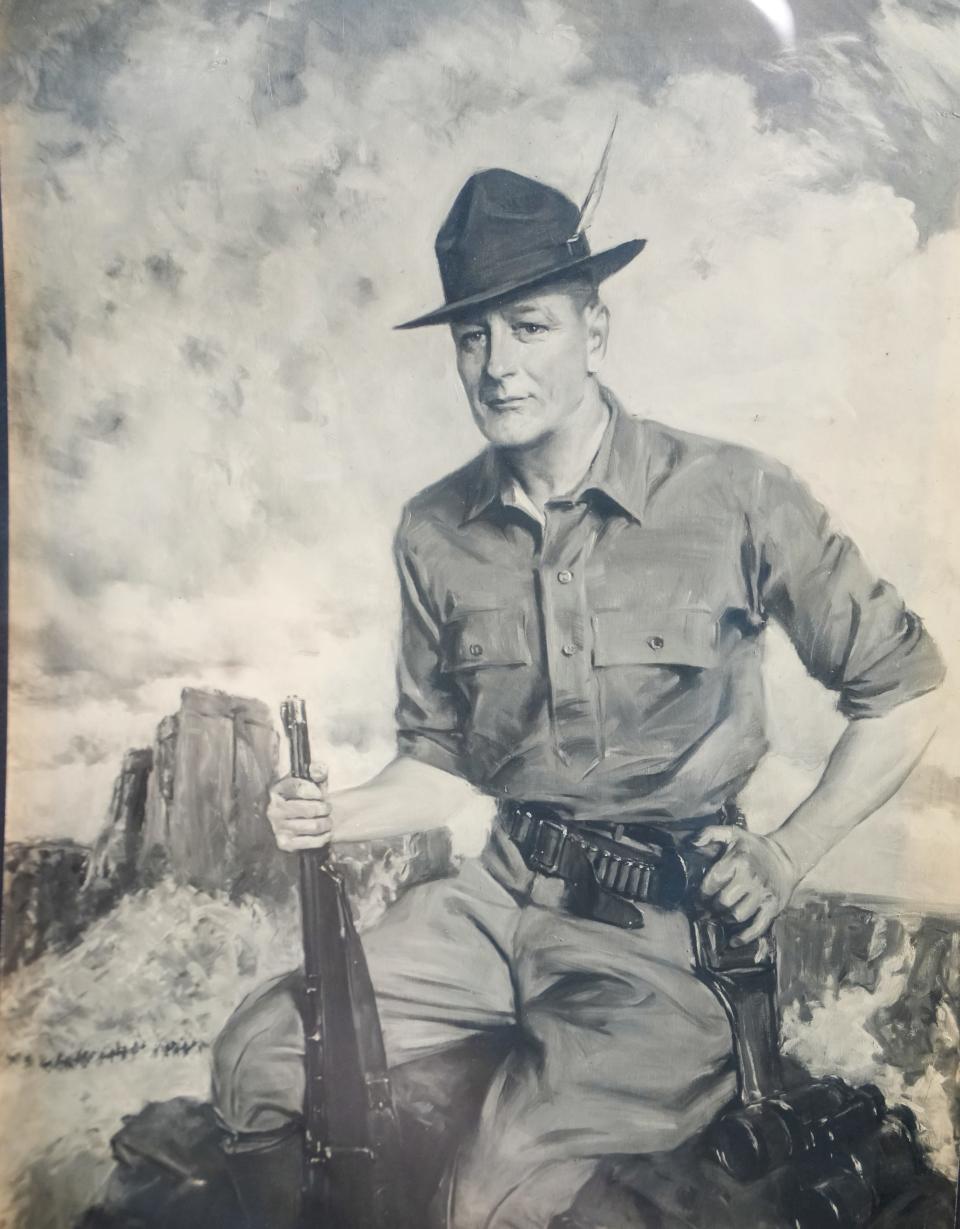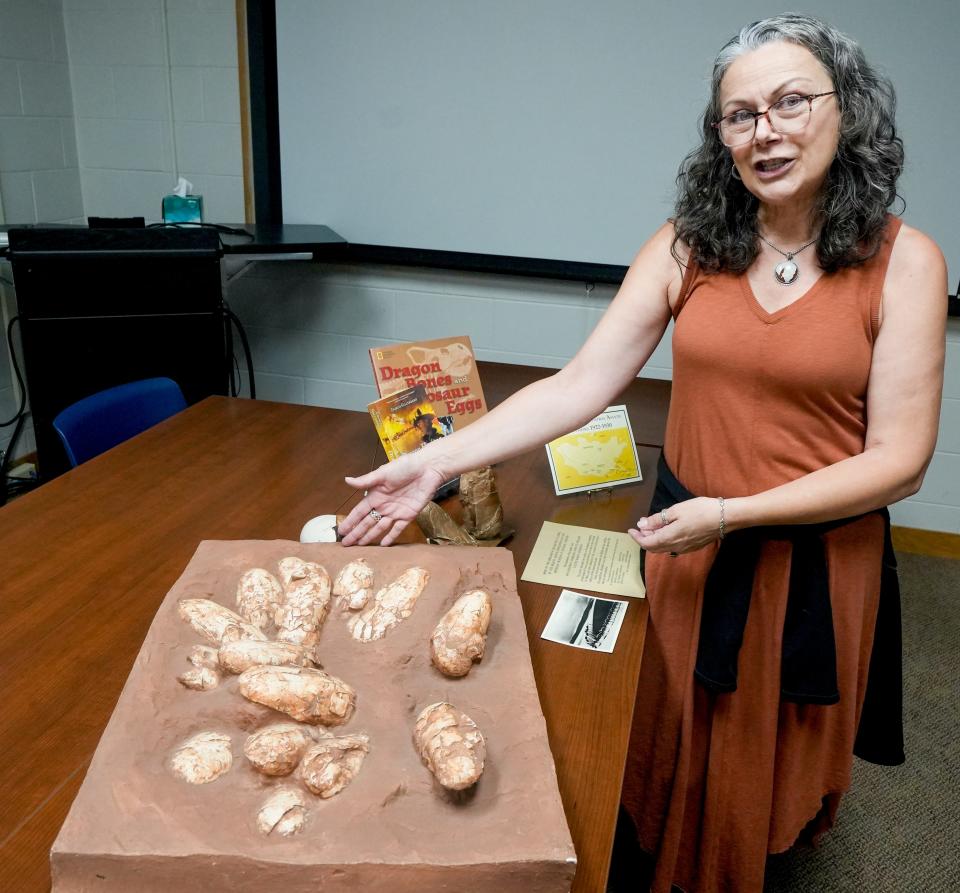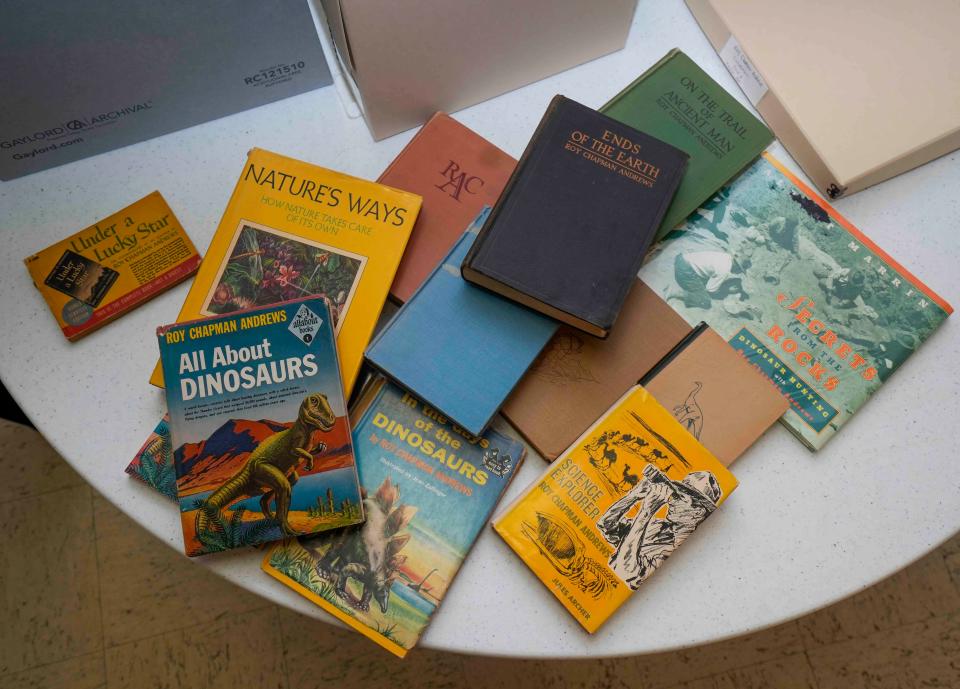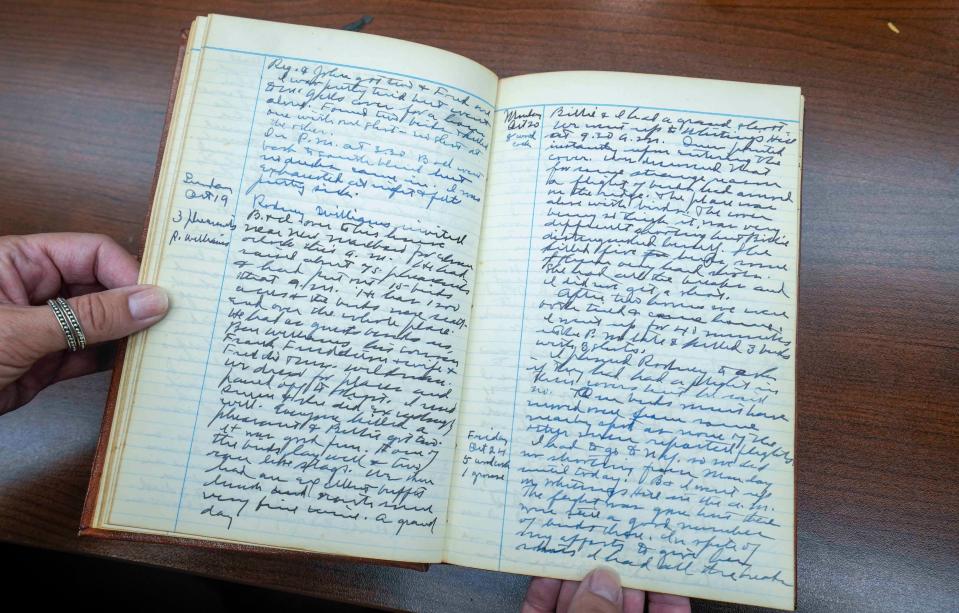Beloit College alumnus might have sparked inspiration for 'Indiana Jones' movies
- Oops!Something went wrong.Please try again later.
They were both known for wearing variations of a fedora hat, embarking on life-threatening adventures around the world and contributing groundbreaking scientific finds. They both hated snakes, too.

If there were any real-life inspiration for the Hollywood character “Indiana Jones,” there could be reason to believe it was Wisconsin native Roy Chapman Andrews, born and raised in Beloit. Although no one associated with the movie character has ever confirmed a connection with Andrews, his life is noteworthy.
Andrews is most notably remembered for his series of five expeditions to previously unexplored areas of Mongolia between 1922 and 1930. During that time, Andrews discovered the first nest of dinosaur eggs in the world, along with fossils of other early mammals that existed with them. He wrote over 22 books, including an autobiography, and worked his way up from mopping floors to being director of the American Museum of Natural History in New York.
But his adventures around the world all tie back to his Wisconsin roots.
Andrews' granddaughter, Sara Appelbee, recently donated her grandfather's memorabilia to the Beloit Historical Society and Beloit College — Andrews' alma mater. The artifacts, which include some of his letters and manuscripts, binoculars, photographs and clothing from communities he visited in Asia, will soon be on display.
While the Beloit College library is undergoing renovations — and the artifacts are not currently on display — planning for the exhibit is taking place. Updates may be found at www.beloit.edu/academics/library-museums.
A lifetime of adventure
“I wanted to go everywhere. I would have started on a day’s notice for the North Pole or the South, to the jungle or the desert. It made not the slightest difference to me,” Andrews wrote in his autobiography “Under A Lucky Star — A Lifetime of Adventure."
While he never did travel to the North or South Pole, Andrews did have a lifetime of adventure.
“(Andrews) grew up here, he went to college here, he's buried here, and so he's just a really wonderful example in which to try to educate people,” said Shannon Fie, president of the Roy Chapman Andrews Society and anthropology professor at Beloit College. "Part of the reason I love this society and this work is because of the commitment to inspiring others to pursue science."
The Roy Chapman Andrews Society is a community organization that works to inspire scientific discovery through the legacy of Andrews’ career of exploration.

'Blockbuster news'
During his expeditions, Andrews discovered the first nest of dinosaur eggs in the world in 1923.
"This was blockbuster news," author and Beloit College alumna Ann Bausum said, as no one previously knew how dinosaurs had reproduced before this find. It was so significant, Time magazine put Andrews on its cover.
Andrews and his team also discovered new species of dinosaurs, including the protoceratops, velociraptors and the oviraptor, along with identifying more than 380 new species of either living or fossilized animals and plants. They made detailed notes on more than 1,500 other species.
Bausum described Andrews as a "prolific writer," and said he often sent dispatches from the field to magazines like the Saturday Evening Post.
Because he was such an excellent communicator, Bausum said, Andrews was able to help build public interest in his field of study.
It was an interest to Bausum years later as well, when asked to write a feature on him for the Beloit College Alumni Magazine — one of her first jobs out of college in the 1980s. The "Indiana Jones" series also began around this time, with "Raiders of the Lost Ark" premiering in 1981.
After reading a book about the history of exploration by scientists from the American Museum of Natural History, she came across a chapter on Andrews’ life.
“They had made the offhand comment that many people thought that Andrews was the real-life model for Indiana Jones,” Bausum said.
Nearly a decade later, as Bausum became an author and a parent, she decided to write her own children’s book on Andrews’ life.
She was inspired by one of Andrews' quotes from his book "On the Trail of Ancient Man":
"In the first fifteen years of field work, I can remember just ten times when I had really narrow escapes from death. Two were from drowning in typhoons, one was when our boat was charged by a wounded whale; once my wife and I were nearly eaten by wild dogs, once we were in great danger from fanatical lama priests; two were close calls when I fell over cliffs, once I was nearly caught by a huge python, and twice I might have been killed by bandits."
“I thought, ‘Well, there's so much material here. If I can't turn this into a children's book, then I'm not ever going to become a children's book author. So let's try it,’” Bausum said.
Bausum published "Dragon Bones and Dinosaur Eggs" in 2000, a children's photobiography of Andrews' life.
The more she read about Andrews, Bausum said, the more impressed she became with his wide range of abilities and accomplishments.
Read more about the franchise: How Harrison Ford immortalized a late Ripon College professor in the Indiana Jones franchise
Wisconsin's ties to the franchise: Indiana Jones says farewell, but this Sheboygan collector continues homage to the legend

Unusual expeditions
From starting off mopping floors as a janitor in 1906 to becoming the director of the American Museum of Natural History in 1934, Andrews spent most of his career exploring for the museum. He retired in 1941.
"This kid was so eager and enthusiastic, he even famously said at one point, 'I'll do anything to work here, I'll even mop the floors' and the director said, 'Well, surely you wouldn't want to do that. You've got a college education,'" Bausum said. "Andrews said, 'Well, not just any floors; these floors are different."
Andrews was hired and began working his way up.
Bausum said Andrews' expeditions were unusual for many reasons during his time, including his choice in transportation, having an interdisciplinary variety of team members and interest in new technology.
Andrews brought experts from a variety of fields, including geology, paleontology and cartography on his travels, which Bausum said was unusual for an expedition in the 1920s. He also brought his wife as their photographer, the only woman to come along.
Andrews chose to travel in motor cars, which were still uncommon in developing countries, and used camel caravans to supply their motor vehicles with supplies and carry some of their scientific finds.
"At that time it was considered outrageous that they could go 20-something miles an hour," Bausum said. "That was like, 'Whoa.' Just the premise and the fact that these logistics were conceived of and actually worked is notable. He was a master of coordinating exploration."
Andrews also recognized the power of photography. On his first expedition documenting whales at sea in 1908, Andrews brought an 8x10 viewfinder camera and motion picture camera. On that trip, Andrews took the first live action pictures of whales that had ever been documented.

A connection to 'Indiana Jones'
The newest Indiana Jones movie, "Indiana Jones and the Dial of Destiny," is in theaters now. But the series has overlapped with several generations of viewers.
Fred Burwell, Beloit College archivist, said he saw the "Raiders of the Lost Ark" for the first time in theaters in 1981.
"Of course I had no idea that within a few years I'd be handling archival materials relating to a legendary real-life Indiana Jones," Burwell said.
Burwell said his favorite Andrews-related materials in the college archives are autographed copies of his books, original copies of a 1930s National Geographic issue featuring his work in the Gobi Desert and several handwritten letters from Andrews to Beloit College.
"A strong collection of Andrews' materials brings visitors to the college but also provides students with a wonderful opportunity to work, hands on, with the stuff of history," Burwell said.
Burwell hopes the artifacts provide a strong college and community bond, along with a fascinating connection to the wider world of anthropology, paleontology and cultural history — including Hollywood, and maybe Indiana Jones.
"A lot of archaeology is dirt and sweat and bugs and being uncomfortable. It's very exciting. They were raided by bandits; they had to deal with wild dogs," Fie said. "That is the kind of the narrative that gets picked up, I think, where we see this comparison to Indiana Jones. The hardship, the excitement, the danger and then the discovery."
If you look at some of the old photographs, you will see sort of a model being presented about what that kind of 1920s and '30s adventure would look like. And he definitely fits that characterization.
“Whether he was the real-life model for Indiana Jones or not, he was an amazing explorer, and it's important to honor that legacy," Bausum said. "But the two of them definitely — the fictional figure and the historical figure — definitely, have similarities. We're trying to keep that legacy alive."
Contact Skyler Chun at schun@gannett.com. Follow her on Twitter at @skylerchun_.
This article originally appeared on Milwaukee Journal Sentinel: Beloit College alumnus said to be inspiration for 'Indiana Jones'

